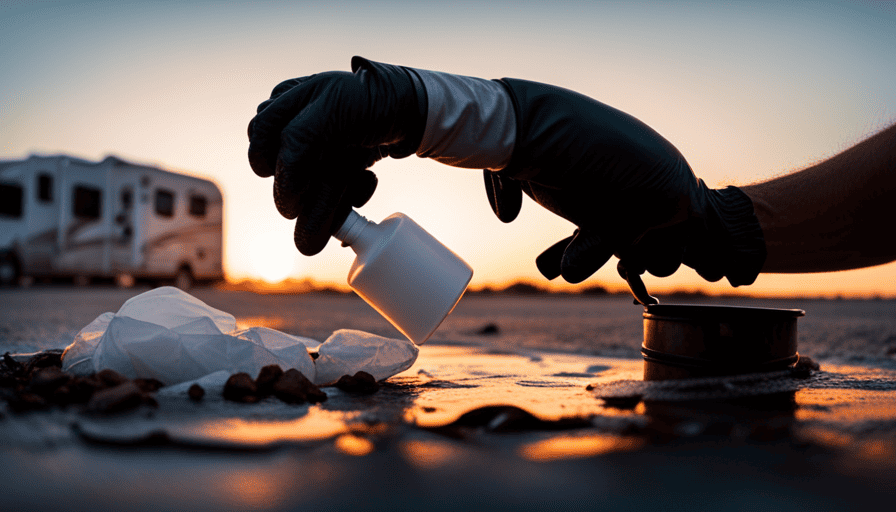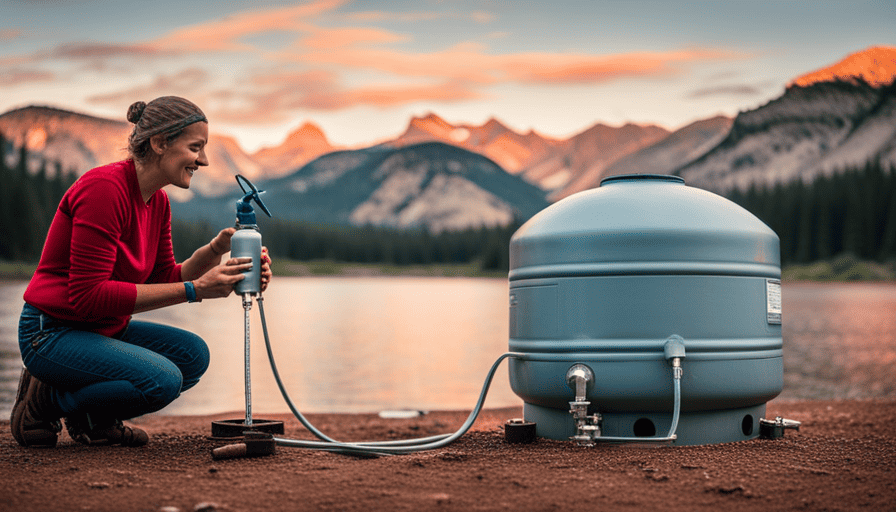Were you aware that one of the prevalent problems among RV enthusiasts is roof leakage? In reality, data indicates that an overwhelming 90% of camper owners will deal with roof leaks at some stage.
This can be a major inconvenience and cause damage to the interior of your camper. However, fear not! With the right knowledge and tools, fixing a camper roof leak can be a manageable task.
In this article, I will guide you through the step-by-step process of repairing a camper roof leak. From assessing the damage to applying roof sealant or patching material, I will provide you with all the necessary information to successfully fix your camper roof.
So, put on your DIY hat and get ready to tackle that leak, ensuring you can enjoy future camping adventures without any worries!
Key Takeaways
- Roof leaks are a common issue for camper owners, with 90% of campers experiencing them.
- Thoroughly assess and inspect the roof for damage, missing shingles, and signs of leaks.
- Gather the necessary materials and tools such as RV roof sealant, putty knife, roofing brush, and ladder for the repair.
- Regular roof inspections, maintenance, and proper sealing can prevent roof leaks and extend the lifespan of the camper roof.
Assess the Damage
Before you can determine the best course of action, you’ll need to thoroughly examine and assess the extent of the damage to your camper’s roof. Conducting a roof assessment is crucial in identifying the areas that need immediate attention.
Start by visually inspecting the roof for any visible signs of damage, such as cracks, tears, or missing shingles. Take note of any water stains or dampness on the interior ceiling, as these indicate the presence of a leak. To ensure a thorough inspection, use a flashlight to check for any hidden damages in corners, seams, and around vents or skylights.
Leak detection is another important aspect of the assessment process. Begin by spraying water onto different areas of the roof while someone else checks for leaks inside the camper. Pay close attention to areas where leaks are commonly found, such as around vents, skylights, or any roof protrusions. If you notice water entering the camper, mark the spot for repair later.
Once you have completed the roof assessment and leak detection, you can proceed to gather the necessary materials and tools for repairing the roof.
Gather the Necessary Materials and Tools
First, make sure you have all the required materials and tools to tackle this issue. To fix a camper roof leak, you will need the following materials: RV roof sealant, putty knife, roofing brush, clean cloth, and a ladder. Additionally, gather the necessary tools such as a caulking gun, screwdriver, and a water hose for testing the repair.
Now, let’s walk through the step-by-step instructions to fix the camper roof leak.
-
Start by cleaning the area around the leak with a clean cloth and water. Remove any dirt, debris, or loose material. This will ensure proper adhesion of the roof sealant.
-
Use a putty knife to apply the RV roof sealant over the damaged area. Spread it evenly, making sure to cover the leak and extend the sealant a few inches beyond it.
-
Smooth out the sealant with a roofing brush to create a uniform layer. This will help prevent water from seeping into the roof.
-
Allow the sealant to dry completely before testing the repair. Use a water hose to spray water over the repaired area and check for any signs of leakage.
With the camper roof leak fixed, we can now move on to the next section about cleaning and preparing the roof surface without delay.
Clean and Prepare the Roof Surface
To ensure a successful repair, you’ll want to start by thoroughly cleaning and preparing the surface of your camper’s roof. This step is crucial for long-lasting results. Did you know that a study found that proper cleaning and preparation can increase the adhesion of roof sealants by up to 50%?
Begin by removing any loose debris, such as leaves or dirt, from the roof surface. A broom or a leaf blower can be useful for this task.
Next, use a mild detergent mixed with water to scrub the roof, paying special attention to areas that are prone to accumulating dirt and grime.
Rinse the roof thoroughly with clean water and allow it to dry completely before proceeding.
Once the roof is clean, it’s important to inspect it for any signs of damage or wear. Look for cracks, holes, or areas where the roof is deteriorating. If you find any, they’ll need to be repaired before applying the sealant or patching material.
In the subsequent section about applying roof sealant or patching material, we’ll cover the steps to properly repair any damage found during the cleaning and preparation process.
Apply Roof Sealant or Patching Material
Now that you’ve cleaned and inspected the roof, it’s time to apply the roof sealant or patching material to ensure a watertight and durable surface. Here’s how to properly apply roof sealant or patching material to fix a camper roof leak:
-
Choose the right roof sealant: There are different types of sealants available, such as silicone or elastomeric sealants. Consider the material of your camper roof and the specific needs of the leak before selecting the appropriate sealant.
-
Prepare the sealant: Read the manufacturer’s instructions carefully to ensure proper mixing or activation of the sealant. Some sealants may require stirring or shaking before use.
-
Apply the sealant: Using a putty knife or a caulking gun, apply the sealant to the damaged area or along the seams and edges of the roof. Make sure to cover the entire affected area with a thick and even layer of sealant.
-
Smooth and feather the edges: Use the putty knife to smooth the edges of the sealant, feathering it out onto the surrounding roof surface. This helps to create a seamless and blended appearance.
Now that the roof sealant has been applied, it’s important to ensure proper adhesion and a smooth surface for optimal performance.
Ensure Proper Adhesion and Smooth Surface
Achieving a secure and flawless surface is crucial to guaranteeing long-lasting protection, giving you peace of mind and safeguarding your investment. To ensure proper adhesion and a smooth surface for your camper roof patch, follow these steps:
-
Start by preparing the surface. Use sandpaper to gently roughen the area around the leak and remove any loose debris or old sealant. This will create a better surface for the adhesive to bond to.
-
Next, apply an adhesive primer to the prepared area. This primer helps the patching material adhere more effectively to the roof. Follow the manufacturer’s instructions for application and drying time.
To grab your attention, here’s a table highlighting the key steps:
| Step | Action |
|---|---|
| 1 | Sand the area around the leak |
| 2 | Apply adhesive primer |
By following these steps, you’ll achieve a secure and flawless surface, ensuring optimal adhesion and protection against leaks. Now, let’s move on to the next section where we will test for leaks and make further repairs if needed.
Test for Leaks and Make Further Repairs if Needed
Let’s move on to testing for leaks and making any necessary repairs if needed. To ensure the effectiveness of our repairs, we need to test the roof for any remaining leaks.
Here are some test methods that can help identify the presence of leaks:
-
Visual Inspection: Carefully examine the roof for any signs of water stains, discoloration, or mold growth. This can indicate the location of a leak.
-
Hose Test: Use a garden hose to spray water on different areas of the roof. Start from the bottom and work your way up. Observe if any water enters the camper. Pay close attention to seams, vents, and any other potential problem areas.
-
Smoke Test: Seal all openings on the camper roof and fill it with smoke. If there are leaks, the smoke will escape from those areas, making it easier to pinpoint the source.
-
Pressure Test: Use a pressure testing kit to pressurize the camper’s interior. This will help identify any leaks by causing visible air bubbles or hissing sounds.
Common causes of camper roof leaks include deteriorated sealants, cracked or damaged roofing material, or improper installation. If leaks are identified during testing, make further repairs as needed.
To maintain a leak-free camper roof, it’s crucial to perform regular roof inspections and maintenance.
Let’s dive into this topic in the next section.
Maintain Regular Roof Inspections and Maintenance
Ensure that you regularly inspect and maintain your camper’s roof to keep it in optimal condition and prevent any unwanted surprises. Regular roof maintenance is essential to identify and address potential issues before they become major problems. By following proper roof inspection techniques, you can detect leaks or damage early on and take necessary action.
To effectively inspect your camper’s roof, consider the following roof inspection techniques:
-
Visual Inspection: Carefully examine the entire roof surface for signs of cracks, punctures, or loose seals. Pay special attention to seams, vents, and any other potential entry points for water.
-
Sealant Check: Inspect the condition of the sealant around roof vents, antennas, and other accessories. Replace any deteriorated or cracked sealant to maintain a watertight seal.
-
Cleanliness: Keep the roof clean and free from debris, as it can trap moisture and lead to roof decay. Regularly sweep away leaves, branches, and other debris that may accumulate.
Regular roof inspections, combined with proactive maintenance, will help extend the lifespan of your camper’s roof and prevent leaks. By keeping an eye on your roof’s condition, you can address any issues promptly and avoid costly repairs down the road.
Transitioning to the next section, it is crucial to consider preventive measures to avoid future leaks and maintain your camper’s roof in excellent condition.
Consider Preventive Measures to Avoid Future Leaks
To prevent any potential issues, you’ll want to take proactive steps to safeguard your camper’s roof and maintain its integrity. By implementing preventive measures and regularly performing maintenance tasks, you can avoid future leaks and ensure the longevity of your camper’s roof.
Here are three important preventive measures to consider:
-
Clean and inspect the roof regularly: Remove any debris such as leaves, twigs, or dirt that can accumulate on the roof. Inspect the roof for any signs of damage, such as cracks, loose seams, or worn-out areas.
-
Apply a protective coating: Consider applying a high-quality roof sealant or coating to provide an extra layer of protection against water intrusion. This can help prevent leaks and extend the lifespan of your roof.
-
Check and maintain roof components: Inspect and maintain the roof vents, skylights, and other components regularly. Ensure they’re properly sealed and functioning correctly to prevent water from entering through these areas.
Implementing these preventive measures is crucial in maintaining the integrity of your camper’s roof and avoiding potential leaks. However, if you encounter any persistent or severe issues, it may be necessary to seek professional help to address the problem effectively.
Seek Professional Help if Necessary
After considering preventive measures to avoid future leaks in your camper roof, it is important to acknowledge that sometimes these measures might not be enough. When you encounter a stubborn leak that just won’t go away, it may be time to seek professional help. Knowing when to DIY and when to hire a professional is crucial to ensure the job is done correctly and efficiently.
While fixing a camper roof leak can be a rewarding DIY project, there are instances where it is best to leave it to the experts. If you lack the necessary tools, skills, or experience, attempting to fix a complex leak may result in further damage to your camper. Additionally, if the leak is extensive or involves structural damage, it is advisable to consult a professional who can assess the situation accurately and provide the appropriate solutions.
Common mistakes to avoid when fixing a camper roof leak include using improper sealants, neglecting to address underlying issues, and failing to properly inspect the entire roof. By hiring a professional, you can avoid these pitfalls and ensure a thorough and long-lasting repair.
With the knowledge and expertise of a professional, you can enjoy leak-free camping adventures without worrying about the integrity of your camper roof.
Enjoy Leak-Free Camping Adventures!
Indulge in worry-free camping adventures and relish in the bliss of a leak-free experience! To ensure your camper roof remains watertight and free from leaks, it’s essential to implement preventive maintenance and effective waterproofing techniques. Here are some key tips to keep in mind:
-
Regular Inspection: Perform routine inspections of your camper roof to identify any potential issues. Look for cracks, gaps, or damaged sealants that may allow water to seep through.
-
Clean and Clear: Keep your camper roof clean from debris, leaves, and twigs that can accumulate and block water drainage. Regularly remove any buildup to prevent water pooling and potential leaks.
-
Sealant Application: Apply a high-quality sealant to all seams, joints, and edges of your camper roof. This’ll create a watertight barrier and prevent water intrusion.
By following these preventive maintenance and waterproofing techniques, you can enjoy worry-free camping adventures without the fear of a leaky roof. Remember, investing time and effort in maintaining your camper roof will go a long way in ensuring a comfortable and dry camping experience. So go ahead, explore the great outdoors with confidence, and let the raindrops dance harmlessly on your trusty waterproofed camper roof!
Frequently Asked Questions
How can I prevent future leaks in my camper roof?
To prevent future leaks in my camper roof, I implement a range of preventive measures and long-term solutions.
Firstly, I regularly inspect and maintain the roof, checking for any signs of wear or damage. I ensure that all seams and seals are properly sealed using a high-quality sealant.
Additionally, I utilize a protective roof coating that provides an extra layer of defense against moisture and UV rays.
These measures help keep my camper roof leak-free for years to come.
What materials and tools do I need to fix a camper roof leak?
To fix a camper roof leak, you’ll need a few materials and tools. Firstly, you’ll need a sealant specifically designed for camper roof repair, such as an RV roof sealant. Additionally, you’ll need a brush or roller to apply the sealant evenly.
It’s also crucial to have a ladder or step stool to safely access the roof. Lastly, make sure to wear protective gloves and goggles for safety.
These waterproofing techniques will help you effectively repair your camper roof.
How often should I inspect and maintain my camper roof?
Inspecting and maintaining your camper roof is crucial to avoid costly repairs. Did you know that 90% of roof leaks in campers can be prevented with regular inspections?
To ensure your roof stays in top condition, inspect it at least twice a year or before and after each camping season. Look out for signs of a roof leak, such as water stains, mold, or sagging ceiling panels. Promptly addressing these issues can save you from expensive repairs down the road.
Can I use any type of roof sealant or patching material?
When it comes to fixing a camper roof leak, it’s important to choose the right roof sealant or patching material. While there are alternative roof sealants available, it’s crucial to consider the pros and cons of different options.
Some sealants may provide better waterproofing, while others may offer longer-lasting protection. It’s essential to select a sealant or patching material that’s compatible with your camper roof material and provides an effective and durable solution for your specific leak issue.
When should I seek professional help for a camper roof leak?
When it comes to a camper roof leak, I believe it’s always best to call a professional right away. Ignoring signs of a severe leak can lead to costly damage and even compromise the structural integrity of your camper.
Factors to consider before attempting DIY repairs include your experience level, the extent of the leak, and the type of roof material. Trust me, it’s better to play it safe and let the experts handle it.
Are the Steps to Fixing a Camper Roof Leak the Same for a Leaking Camper Roof?
When it comes to fixing a leaking camper roof, the steps vary depending on the type of leak. However, the overall process usually involves identifying the source of the leak, cleaning the affected area, applying sealant or patching materials, and allowing sufficient drying time. It’s crucial to address roof leaks promptly to prevent further damage and maintain the integrity of your camper.
Conclusion
Well, there you have it, folks! With a little bit of time, effort, and the right materials, you can fix that pesky camper roof leak and get back to enjoying your camping adventures.
Remember, just like patching up a leaky roof is a necessary task, regular inspections and maintenance are key to preventing future leaks. So, keep an eye on your roof, take preventive measures, and you’ll be cruising down the open road with a leak-free camper in no time.
Happy camping!










